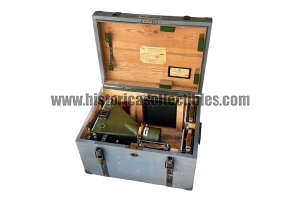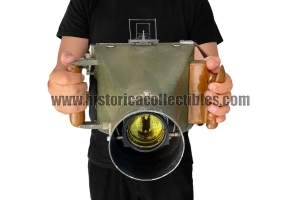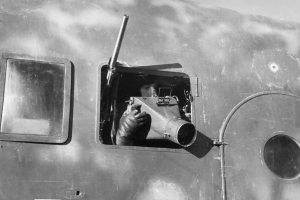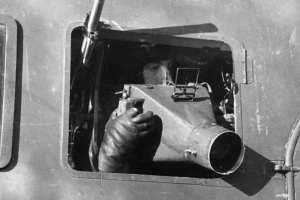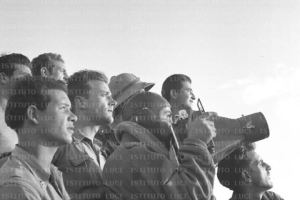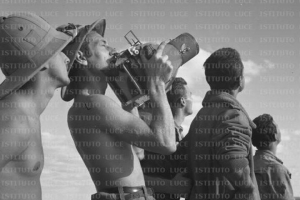Military Camera OMI-Nistri Rome, mod. APR3, Italian Royal Air Force, circa 1940
Military camera for aerial photography, produced by OMI Nistri - Rome, for the Italian Royal Air Force in around 1940 and made of light die-cast alloy (Duralluminium or Dural) with a truncated pyramid shape, with two wooden handles inserted laterally and a steel strap. leather for transportation. This camera, called mod. OMI-A.P.R.3, has a 13x18 cm split plate format with a curtain shutter that releases from 1/100 of a second to 1/500 of a second and rapid charging via a lever located near the shutter button.
In front of the film holder is the actual camera on which a folding Newtonian viewfinder and the shutter release are mounted. The camera ends with the lens holder covered by a metal cap where the 250 mm f4.5 fixed focus lens produced by Officine Galileo - Florence is inserted, with an aperture adjustment device of 4.5 - 6.3 - 9, and a lever placed laterally is used to insert a yellow folding filter.
The method of use of this device was relatively simple, it was held in the operator's hand through the two wooden handles, he loaded the mechanism useful for bringing the film frame into position, adjusted the opening of the diaphragm and inserted if necessary, the yellow filter in the presence of fog or clouds, framed the subject through the viewfinder, and finally pressed the shutter button.
This photographic device was used for taking aerial photographs or for filming in flight and was used freely by hand by a member of the plane's crew (in some period photos, it appears to be used by a machine gun operator).
The photographic device is contained in its original wooden case in which there are also 3 detachable plate holders and a curtain complete with the relative shutter mechanism.
Special note:
Inside the wooden case, there is a document showing the name of the airport "Campo della Promessa - Lonate Pozzolo" and "7° Stormo" with some coding relating to the unloading registration of the logistics warehouse towards which , the photographic equipment had probably been assigned.
The overall aesthetic and operating conditions are excellent.
Dimensions: 36cm x 43cm x 23cm.
Some historical news:
The needs of taking aerial photographs were initially of a military nature and there were numerous photographic devices supplied to American and English airmen during the Second World War. Another sector in which photogrammetry developed was that of topographical surveys: in 1851 the Captain of the French Engineers Laussedat began to study the way to replace hand-drawn perspectives with photographs and in 1858 he created the first photogrammetric machine composed of a camera combined with a collimator telescope.
Oblique cameras for aerial use, used freehand, arise from the adaptation of terrestrial cameras to flight needs. The actual aerophogrammetry devices, intended for vertical recordings, were installed in a fixed position on the aircraft. These devices often lack almost all the elements that make a camera recognizable as such (viewfinder, shutter button, shutter speed control) and the shape and dimensions, no longer subject to ergonomics, are functional to the internal parts. They have remote electrical controls and can often have more than one lens.
Starting from the early 1900s, armies used observers on balloons to guide artillery fire. During the First World War, aerial reconnaissance was fundamental for the tactics of the armies and during the Second World War it became systematic and of fundamental support for the planning of bombing missions and for the evaluation of the effects.
Meanwhile, between the two wars, the use of aerial photographs for the creation of topographic maps developed. In the 1920s and 1930s, aerial photography also performed celebratory and propaganda tasks. Today, the advent of satellite imagery has made the use of aerial photography for military or topographical purposes obsolete.
History of Omi-Nistri:
The Omi-Nistri Roma Ottica Meccanica Italiana company of the Nistri brothers based in Rome began its activity during the First World War and specialized in the construction of photographic equipment for the Air Force to be used in aerial reconnaissance (planimetric and perspective equipment) and in shooting schools (photo machine guns).
The anonymous company Ottico Meccanica Italiana e Rilevamenti Aerofotogrammetrici was founded as early as 1924, but it was only in 1937-38 that its headquarters were built in the San Paolo area for the production of precision optical instruments for the Air Force.
Around 1938, OMI established itself on international markets for the export of aeronautical material and in the years of the Second World War, the company took on strategic importance, given its mainly military production. At the end of the Second World War, OMI, like other Italian industries producing military equipment, found itself in the position of having to forcibly change its reference market.

